AMD’s Radeon HD 6670 & Radeon HD 6570: Two’s Company, Sub-$100’s A Crowd
by Ryan Smith on April 19, 2011 12:01 AM ESTPower, Temperature, and Noise
Last but not least as always is our look at the power consumption, temperatures, and acoustics of the Radeon HD 6670 and Radeon HD 6570. As we’ve noted previously, these reference designs won’t be sold in the retail market, so while our performance data and power data should be consistent with other cards, temperature and noise data is going to be very dependent on the specific cooler used.
| Radeon HD 6570/6670 Voltage | |||||
| 6570 Idle | 6670 Idle | 6570 Load | 6670 Load | ||
| 0.9v | 0.9v | 1.1v | 1.1v | ||
Both the 6670 and 6570 have the same load voltage of 1.1v. This caught us a bit off guard, since lower clocked parts normally enjoy a lower load voltage. This will be of importance when we’re looking at load power consumption.
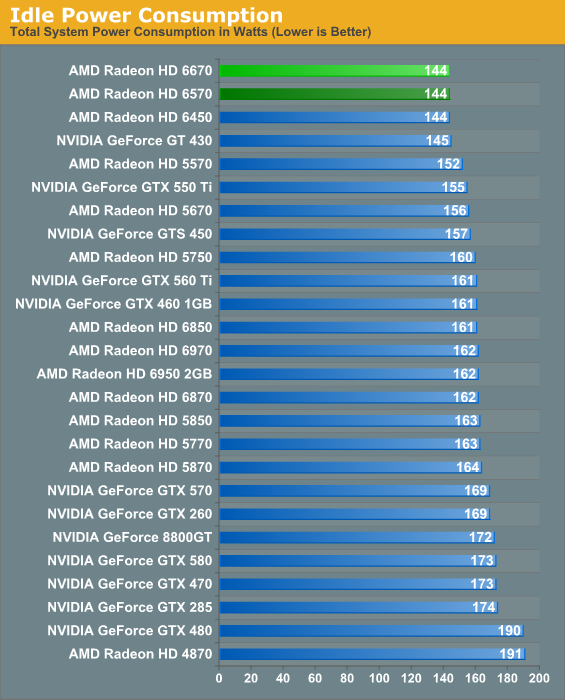
At idle we’re running up against the limits of what a 1200W PSU can do. In reality the 6450 should be consuming at least a few watts less than the 6670 and 6570. The fact that all 3 cards are among the lowest power consuming cards at idle is not a mistake, however.
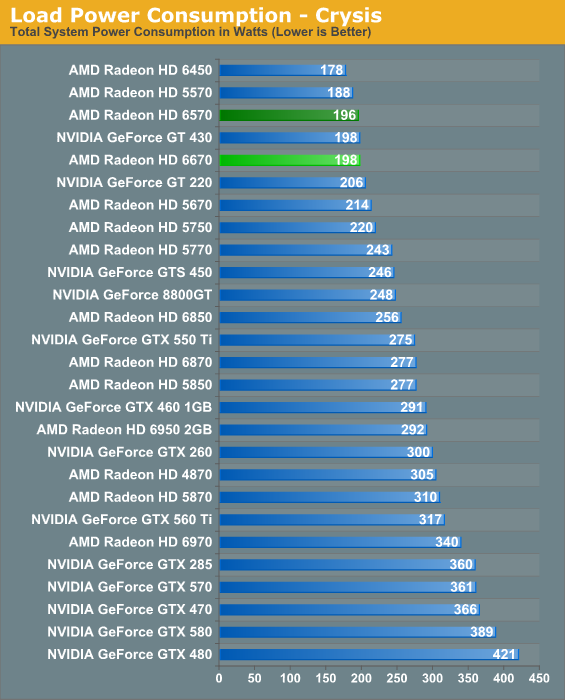
Our Crysis power data surprised us some, and we’re still trying to get to the whys. Both the 6670 and 6570 ended up being sub-200W; this is notable because the 5670 draws 214W in the same test and has a slightly lower TDP than the 6670. In spite of what the specs say, for whatever reason the 6670 is clearly well ahead of the 5670 in both power consumption and performance when it comes to Crysis.
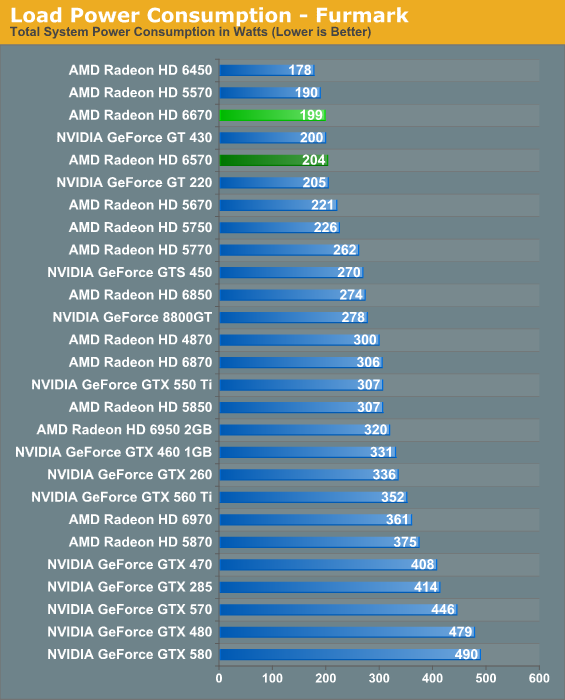
FurMark confirms what we’ve seen with Crysis: the 6670 and 6570 consume less power than the 5670 even with their similar TDPs. In fact the 6570 consumes 5W more than the 6670 even though the latter is the higher clocked and should be the higher consuming card. Given that both cards use fully enabled GPUs at the same load voltage, the difference looks to come down to minor variations in the quality of the individual chips. In this case our 6670 appears to use a better chip than our 6570, hence the difference.
In any case the load power consumption looks very good. The 6670 edges out even the much slower GT 430, while the 6570 similarly edges out the GT 220 DDR3. AMD has done a lot of work on power consumption for Northern Islands and it shows. Meanwhile the fact that the 5750 draws around 25W more is both a curse and a blessing – 25W is quite a lot when Turks cards only draw around 60W in the first place, on the other hand that 25W comes with a lot more performance.
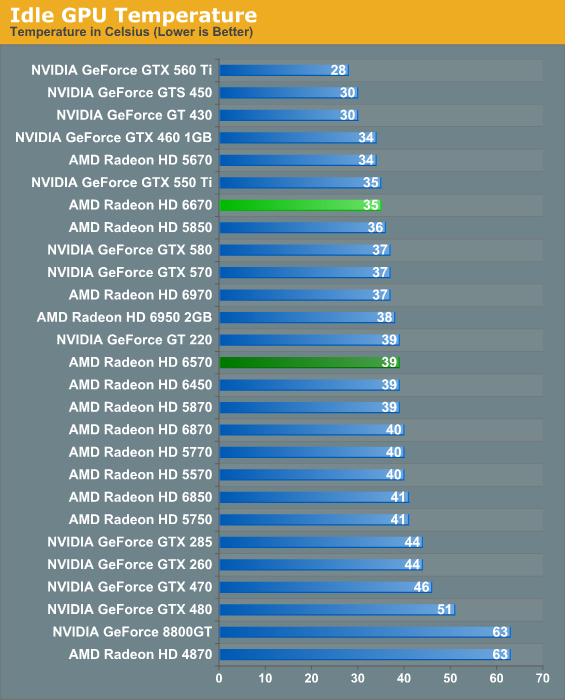
Idle temperatures are roughly where we expect them to be. The 6570 is consistent with the other cards using that model cooler, while the 6670’s new double-wide cooler makes it competitive with all but the coolest of our cards.
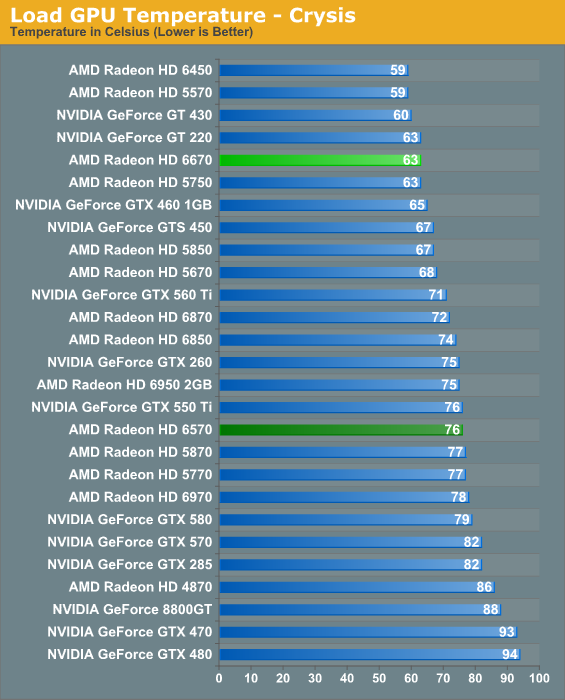
Since we’ve already established that the 6670 and 6570 have similar levels of power consumption, temperatures are almost entirely a product of the cooler in use. The 6670 has a larger cooler that can move more air, and as a result it’s much cooler than the 6570 under Crysis. In fact the 6570 is probably at its limits for what AMD’s single-wide low-profile cooler can do; dissipating the roughly 40W the GPU produces is no small task for such a small cooler.

Coming from Crysis our temperatures rise slightly, as is normally the case. At 69C the 6670 is extremely well cooled, while the 6570 is quite warm at 82C. Though we won’t see either cooler at retail, this should be a good idea of the range we should expect to see. A double-wide cooler should make for a very cool card, while a single-wide cooler delivers reasonable performance but it will definitely be warm.
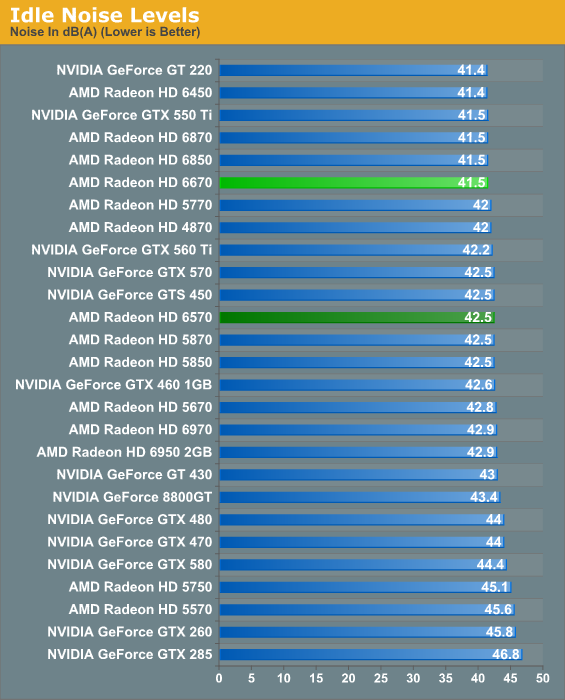
For idle noise, both the 6670 and 6570 are where we’d expect them to be, which is to say almost silent. The 6570 does end up being a bit louder than our noise floor though, which is an interesting outcome given that the 6450 and 5570 are at the noise floor using the same cooler.
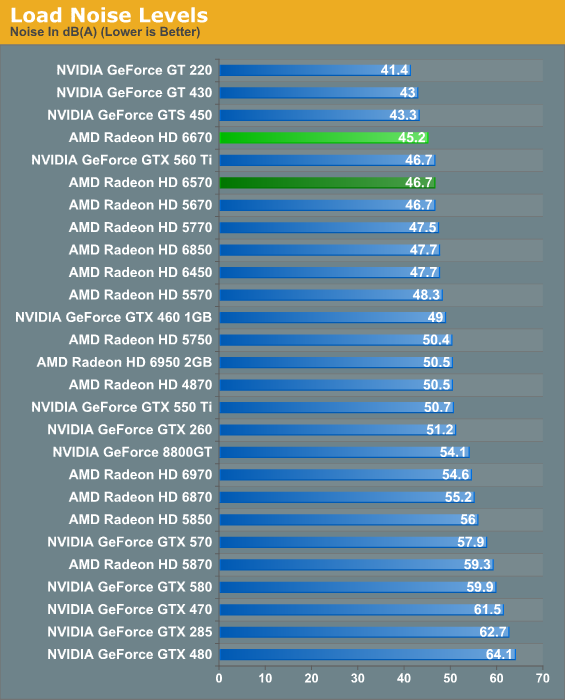
We’re not going to read into our noise results since partner cards will be so different, but if they’re anything like the AMD reference cards then things look pretty good. We’ve had quieter cards, but nothing pushing 60W in a low-profile form factor. If partners go with a full-factor design, then they should be able to meet (or beat) the GTS 450 in noise levels at the cost of some space.
Meanwhile we expect to see passively cooled cards, which should be quite attainable with a full-factor card to hold a larger heatsink.










53 Comments
View All Comments
Taft12 - Tuesday, April 19, 2011 - link
Courtesy of Hardwarezone (and Techconnect), here's a look at what many of the major AMD video card hardware partners have for us on release day:ASUS:
http://www.hardwarezone.com/tech-news/view/166085
Gigabyte:
http://www.hardwarezone.com/tech-news/view/166139
MSI:
http://www.hardwarezone.com/tech-news/view/166128
Sapphire:
http://www.hardwarezone.com/tech-news/view/166079
HIS:
http://www.tcmagazine.com/tcm/news/hardware/37325/...
Powercolor:
http://www.tcmagazine.com/tcm/news/hardware/37324/...
Highlights (for me): the HIS fanless 6570 and that dual-fan MSI 6670! I'm sure many more overclocked and exotic cooler models (like MSI Cyclone and HIS IceQ) are on their way
LB-ID - Tuesday, April 19, 2011 - link
The eternal question.ekoostik - Thursday, April 21, 2011 - link
I just read all the comments looking for something like this. Thanks for not letting me down. Ryan, nice TMBG reference.larson0699 - Tuesday, April 19, 2011 - link
We know, we know. The article immediately reads "copypasta" when I see this. *sigh*jah1subs - Tuesday, April 19, 2011 - link
Personally, I expect my next build to be used mostly as a work (browser + Office 2010) PC (no games) and to be used sometimes as an HTPC and -- very infrequently -- a video encoder since our only child will probably be more than 500 miles away, going to college. I am cheap, especially about electricity. My apartment is all fluorescents today and I am impatiently waiting for 5000K LED bulbs.Therefore, I may be looking at the 6570, or, more likely, the 6450. But what about the Sandy Bridge integrated 3000 graphics? Below, I have copied several paragraphs about the 23.976 fps problem from The Sandy Bridge Review, "A Near-Perfect HTPC." What is the current status of the software fix mentioned in the last paragraph? Is it available? Have you tested it?
"What happens when you try to play 23.976 fps content on a display that refreshes itself 24.000 times per second? You get a repeated frame approximately every 40 seconds to synchronize the source frame rate with the display frame rate. That repeated frame appears to your eyes as judder in motion, particularly evident in scenes involving a panning camera."
"How big of an issue this is depends on the user. Some can just ignore the judder, others will attempt to smooth it out by setting their display to 60Hz, while others will be driven absolutely insane by it."
"If you fall into the latter category, your only option for resolution is to buy a discrete graphics card. Currently AMD’s Radeon HD 5000 and 6000 series GPUs correctly output a 23.976Hz refresh rate if requested. These GPUs also support bitstreaming Dolby TrueHD and DTS-HD MA, while the 6000 series supports HDMI 1.4a and stereoscopic 3D. The same is true for NVIDIA’s GeForce GT 430, which happens to be a pretty decent discrete HTPC card."
"Intel has committed to addressing the problem in the next major platform revision, which unfortunately seems to be Ivy Bridge in 2012. There is a short-term solution for HTPC users absolutely set on Sandy Bridge. Intel has a software workaround that enables 23.97Hz output. There’s still a frame rate mismatch at 23.97Hz, but it would be significantly reduced compared to the current 24.000Hz-only situation."
Anandtech, thank you in advance for your reply.
Belard - Wednesday, April 20, 2011 - link
For an office/browser setup. Any current technology will work just fine. My old 2009 ThinkPad runs Windows7 pretty good with a PDC 1.8Ghz (bottom end Core2) with crappy intel graphics and 2GB of RAM.The AMD Fusion Llano platform is pretty exciting and its not even the top-end bulldog. Its onboard graphics destroys intel and it'll help the CPU with other tasks.
Sandy bridge is very good of course, so just add a $60~80 video card and you are ready to go. Sad we have to talk about todays CPUs by their code-names.
** Don't expect an answer concerning the 23.976fps issues. Call intel on that one. intel always had and always will have sub-par graphics. Check out HOW stupid Intel is.
For the bottom end SB, it has the worst performing built-in GPU. The top-end has their best, which is still pathetic compared to the graphics built into AMD chipsets. Logic should dictate that the person who spends $500+ on a CPU, is most likely going to have a dedicated video card - DUH! Even a $40 6450 will smoke any built-in Sandybridge graphics. Its the entry level systems that need better graphics.
papapapapapapapababy - Wednesday, April 20, 2011 - link
i got 640 sp in 2009 for 99$... (4770) screw u AMD... go sell this POS to NintendoSpoelie - Wednesday, April 20, 2011 - link
Sapphire just launched an 5850 SKU ("xtreme") at sub 150$ prices...euroland: 115€
http://azerty.nl/0-970-401029/sapphire-radeon-hd-5...
newegg: 145$
http://www.newegg.com/Product/Product.aspx?Item=N8...
crazy prices for the performance
don't know how long supplies will last but it launched less than 10 days ago..
Spazweasel - Friday, April 22, 2011 - link
Has anyone actually seen a low-profile 6670 offered for sale anywhere? I see only a small handful of full-height cards when I search.Taft12 - Monday, April 25, 2011 - link
No OEM ever made a low-profile 5670 and I don't imagine there will be a low-profile 6670 either.